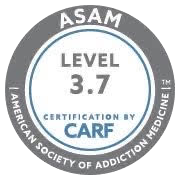Xanax is a brand name benzodiazepine. Benzodiazepines like Xanax are often prescribed for treating anxiety disorders, panic disorders, and, less often, conditions like insomnia. Because of its potency and abuse potential, Xanax is a controlled substance in the United States. When people take higher doses or take them for more extended periods than prescribed, addiction is more likely to occur. The same is true if it’s used recreationally.
Often, once an addiction and dependence on Xanax develops, a professional treatment program is necessary for recovery.
Physical and Mental Xanax Effects
Benzodiazepines are psychoactive drugs. They work by increasing the effects of a neurotransmitter called gamma-aminobutyric acid or GABA. The GABA neurotransmitter helps calm down excessive neuron activity. By increasing the effects of GABA, benzodiazepines, including Xanax, have sedative and hypnotic effects. They also have anxiolytic or anti-anxiety effects, muscle relaxing, and anticonvulsant effects. In the short term, Xanax and other benzodiazepines can be very effective at reducing anxiety. They enhance GABA’s calming effects, reducing excessive anxiety-related neuron firing. They also help induce drowsiness, promoting sleep. Despite the medical effectiveness of benzodiazepines to reduce symptoms of certain conditions, they have risks. The longer someone uses Xanax and similar drugs, and the higher the doses they use, the greater the risks. Risks include:- Tolerance: With continued use, the body might get tolerant to benzodiazepine effects, requiring higher doses for the same therapeutic effects.
- Dependence: With tolerance can come dependence, meaning that withdrawal symptoms occur if benzos are suddenly stopped.
- Addiction: Benzodiazepines have a high addiction potential, mainly if they’re used recreationally or in ways not prescribed by a health care professional. Addiction symptoms include compulsive drug-seeking and continued use, even though adverse effects are occurring as a result.
- Cognitive impairment: Benzos cause confusion, drowsiness, and impaired cognitive function, potentially affecting memory, coordination, and concentration.
- Respiratory depression: High doses of benzos or combining them with other depressants like opioids or alcohol can suppress respiratory function and lead to respiratory depression or life-threatening complications.
Xanax Withdrawal Risks
Even if you decide you want to stop using benzodiazepines, which is a critical first step, you have to be careful in how you go about it. Benzodiazepine withdrawal can be dangerous, especially without proper management. The severity of withdrawal symptoms depends on dosage and duration of use, individual differences, and whether you stop suddenly or taper off gradually. The risks of withdrawal from Xanax and other benzodiazepines can include:- Seizures: One of the most severe risks of benzodiazepine withdrawal is the seizure risk, especially in people who have been using them for an extended period or taking high doses. Life-threatening seizures can occur during the phase of acute withdrawal.
- Delirium: Severe benzo withdrawal can lead to delirium with symptoms like confusion, hallucinations, and agitation. Delirium can impair cognitive function, requiring medical intervention for safe management.
- Psychological symptoms: Withdrawal from benzodiazepines can trigger intense psychological symptoms, including depression, panic attacks, anxiety, mood swings, and emotional instability. The symptoms can cause distress and increase the risk of self-harm or suicidal ideation, especially in people with pre-existing mental health conditions.
- Physical symptoms: Benzodiazepine withdrawal can cause physical symptoms like insomnia, tremors, nausea, vomiting and diarrhea.
- Rebound anxiety and insomnia: Some people experience a rebound in the symptoms the benzodiazepines were initially prescribed to treat, like insomnia or anxiety during withdrawal. The symptoms can end up being more intense than before the medicine started.
Treating Benzodiazepine Addiction
A combination of psychotherapy, medication, and supportive services may be used to treat Xanax addiction. Evidence-based approaches for benzodiazepine addiction treatment should address the physical dependence on the drug as well as the psychological elements of addiction. The steps in a benzodiazepine addiction treatment plan might include:- Medically supervised detox: During medically supervised detox, there’s a gradual tapering off Xanax under a healthcare professional’s supervision to reduce the risk of complications and minimize withdrawal symptoms.
- Pharmacotherapy: Medicines may be used for managing withdrawal symptoms and supporting recovery from benzodiazepine addiction. For example, medications like clonazepam, which are longer-acting, might be substituted for short-acting benzos during the tapering process. Medicines like antidepressants or anticonvulsants can be used for co-occurring anxiety or mood disorders.
- Behavioral therapies: A cornerstone of treating Xanax addiction is behavioral therapy. Cognitive-behavioral therapy and motivational interviewing are among the most common psychotherapeutic approaches to treat benzodiazepine addiction. CBT helps with the identification and modification of maladaptive behaviors and thoughts related to drug use. MI is focused on enhancing the sense of motivation and commitment to change.
- Comprehensive approaches: A comprehensive treatment program that includes a combination of detox, psychotherapy, pharmacotherapy, and support services can be best to treat benzodiazepine addiction. These programs are offered in different settings, including inpatient treatment facilities.



